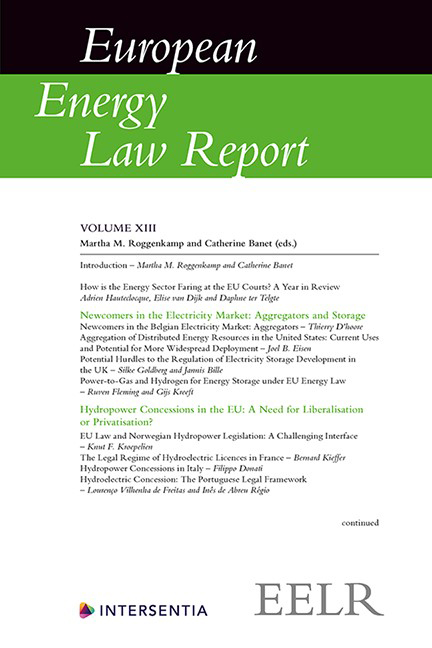Book contents
- Frontmatter
- Preface
- Contents
- List of Abbreviations
- List of Contributors
- Introduction
- Chapter I How is the Energy Sector Faring at the EU Courts? A Year in Review
- PART I NEWCOMERS IN THE ELECTRICITY MARKET: AGGREGATORS AND STORAGE
- PART II HYDROPOWER CONCESSIONS IN THE EU: A NEED FOR LIBERALISATION OR PRIVATISATION?
- PART III INVESTMENTS AND DISINVESTMENTS IN THE ENERGY SECTOR
- PART IV OFFSHORE DECOMMISSIONING IN THE NORTH SEA
- PART V CCS AS A CLIMATE TOOL: NORTH SEA PRACTICE
- PART VI FROM EU CLIMATE GOALS TO NATIONAL CLIMATE LAWS
Chapter XX - Carbon Capture and Storage in the Netherlands: A Long and Winding Process
Published online by Cambridge University Press: 30 April 2020
- Frontmatter
- Preface
- Contents
- List of Abbreviations
- List of Contributors
- Introduction
- Chapter I How is the Energy Sector Faring at the EU Courts? A Year in Review
- PART I NEWCOMERS IN THE ELECTRICITY MARKET: AGGREGATORS AND STORAGE
- PART II HYDROPOWER CONCESSIONS IN THE EU: A NEED FOR LIBERALISATION OR PRIVATISATION?
- PART III INVESTMENTS AND DISINVESTMENTS IN THE ENERGY SECTOR
- PART IV OFFSHORE DECOMMISSIONING IN THE NORTH SEA
- PART V CCS AS A CLIMATE TOOL: NORTH SEA PRACTICE
- PART VI FROM EU CLIMATE GOALS TO NATIONAL CLIMATE LAWS
Summary
INTRODUCTION
Carbon capture and storage (CCS) has been a policy of the Dutch government for almost two decades, although the interest in developing CCS has faced many ups and downs. The interest in CCS started as an important instrument in the process of energy transition, i.e. a policy aiming to transition away from a fossil fuel economy and to limit the level of CO2 emissions.
The policy of energy transition was developed by several ministries in early 2000 and led to the establishment of the Energy Transition Task Force (ETTF) in January 2005, which consisted of representatives from industry, government, research organizations, financial institutions and non-governmental organizations (NGOs). In the Transition Action Plan ‘More with Energy’ that was presented in May 2006, the task force set some ambitious goals for 2050, i.e. energy savings of 1.5 to 2 per cent each year, a substantial use of renewable energy sources and a reduction of CO2 emissions by half (compared to 1990) and at the same time strengthening the position of Dutch industry. In order to make the gas industry more sustainable, the task force considered the need for projects involving CO2 capture and (underground) storage. As part of a Working Programme ‘Clean and Efficient’ of 2007 the Dutch government aimed at examining the possibility of CCS and to develop and subsidise three demonstration projects in the Netherlands. The task force even presented the ambitious idea that the Netherlands could be turned into an EU CO2 hub due to the expected large number of (soon to be) depleted oil and gas fields. It thus focused on developing CO2 storage locations onshore as suitable reservoirs would (soon) become available and it was the least costly option. Despite a serious attempt to set up a pilot phase in Barendrecht where Shell was involved both as the capturer at a refinery near Rotterdam and as the holder of a gas production licence (and potential storage licence), the project failed due to major public opposition. As a result, no storage licence was award for this project.
- Type
- Chapter
- Information
- European Energy Law Report XIII , pp. 405 - 418Publisher: IntersentiaPrint publication year: 2020

